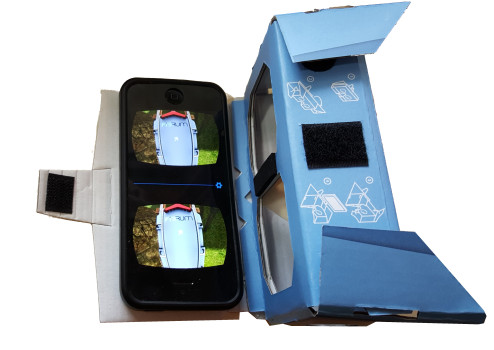
Today in the mail a manufacturer sent me a free review copy of the ViarBox Google Cardboard headset.
If you’re in Europe, you can buy these at around $17 each with a headstrap and $15, which is roughly about what any of the brand-name Google Cardboards cost, or a little less.
Now, the ViarBox does offer some advantages over a standard Cardboard. It comes in a pretty color, it has straps, and it has some padding around the nose and forehead.
Once unfolded, just drop in your smartphone and fold up the outside cover.

My only quibble is the lack of a QR Code printed anywhere on the headset. You need the QR Code to correctly calibrate all those 1,000-plus virtual reality applications you’re going to be trying out. And it’s especially useful if you own more than one headset and have to switch back and forth. The company did email me the QR Code, but it’s a pain to have to find it on the computer each time you switch headsets.

I was surprised by the lack of a button, either the old-school magnetic type of the new capacitative touch, but the company solves this problem with openings on the left and right sides of the headsets. That allows you to simply reach in and touch the screen when you need to interact with an app. Plus, it reduces the number of moving parts, which has to be a good thing.

It also flips into place really easily and folds flat again.
But that’s not the main benefit.
The reason you might want to look at it is as a custom headset that you would buy in bulk to distribute to customers or business partners.

“We are making full customizable design, so our focus is B2B,” company spokesman Dejan Gajsek told Hypergrid Business.
According to the company, prices drop to just $5 per unit when ordering 500 or more, and there’s free shipping for more than 300 pieces. Shipping takes five days inside Europe, and ten days to the U.S.
My headset fit my iPhone 5s and my Samsung Galaxy S6 comfortably but, according to Gajsek, larger phones, such as the iPhone 6 plus, won’t fit. There is an extra large version of the headset also available, however.
Bottom line: nice version of Google Cardboard when you need a branded virtual reality headset, but ask the company to print the QR Code on the inside cover.
Other companies offering branded headsets made out of cardboard: I Am Cardboard, KnoxLabs, PowisVR.
- Analysts predict drop in headset sales this year - March 25, 2025
- OSgrid enters immediate long-term maintenance - March 5, 2025
- OSgrid wiping its database on March 21: You have five weeks to save your stuff - February 15, 2025
